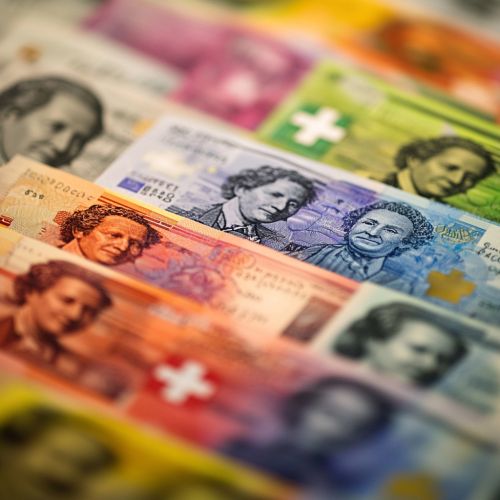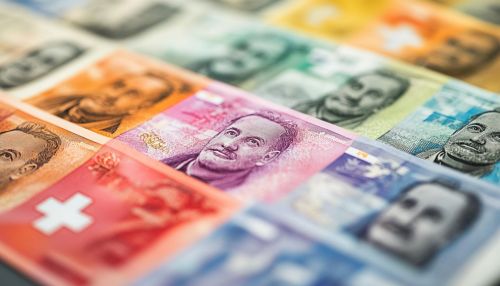Swiss franc: Difference between revisions
(Created page with "== Introduction == The Swiss franc (CHF) is the official currency of Switzerland and Liechtenstein. It is also used in the Italian exclave of Campione d'Italia and the German exclave of Büsingen am Hochrhein. The Swiss franc is abbreviated as CHF, which stands for "Confoederatio Helvetica Franc." The currency is known for its stability and is often considered a safe-haven currency in times of economic uncertainty. == History == === Early History === The Swiss franc was...") |
No edit summary |
||
| Line 27: | Line 27: | ||
The ninth series of Swiss banknotes includes denominations of 10, 20, 50, 100, 200, and 1000 francs. Each banknote features a different theme, such as time, light, and water, and incorporates advanced security features to prevent counterfeiting. | The ninth series of Swiss banknotes includes denominations of 10, 20, 50, 100, 200, and 1000 francs. Each banknote features a different theme, such as time, light, and water, and incorporates advanced security features to prevent counterfeiting. | ||
[[Image:Detail-98091.jpg|thumb|center|Swiss franc banknotes of various denominations laid out on a table.|class=only_on_mobile]] | |||
[[Image:Detail-98092.jpg|thumb|center|Swiss franc banknotes of various denominations laid out on a table.|class=only_on_desktop]] | |||
=== Coins === | === Coins === | ||
Latest revision as of 09:01, 24 September 2024
Introduction
The Swiss franc (CHF) is the official currency of Switzerland and Liechtenstein. It is also used in the Italian exclave of Campione d'Italia and the German exclave of Büsingen am Hochrhein. The Swiss franc is abbreviated as CHF, which stands for "Confoederatio Helvetica Franc." The currency is known for its stability and is often considered a safe-haven currency in times of economic uncertainty.
History
Early History
The Swiss franc was introduced in 1850, replacing the various currencies of the Swiss cantons, which had been in use since the Middle Ages. The new currency was based on the French franc and was initially pegged to it. The introduction of the Swiss franc was part of a broader effort to unify the Swiss monetary system and facilitate trade and economic development.
20th Century
During the 20th century, the Swiss franc underwent several changes. In 1920, Switzerland joined the League of Nations, and the Swiss franc became an internationally recognized currency. The Bretton Woods Agreement of 1944 further solidified the Swiss franc's status as a stable currency, as it was pegged to the US dollar. However, Switzerland did not join the International Monetary Fund (IMF) until 1992.
Modern Era
In the modern era, the Swiss National Bank (SNB) has maintained a policy of monetary stability. The Swiss franc is known for its low inflation rate and strong purchasing power. In 2011, the SNB set a minimum exchange rate of 1.20 CHF per euro to combat deflationary pressures. This policy was abandoned in 2015, leading to a significant appreciation of the Swiss franc.
Monetary Policy
The Swiss National Bank is responsible for the country's monetary policy. Its primary objective is to ensure price stability while taking into account economic developments. The SNB uses various tools to achieve this goal, including interest rate adjustments and foreign exchange interventions.
Interest Rates
Interest rates in Switzerland have historically been low, reflecting the country's stable economic environment. The SNB sets the target range for the three-month Swiss franc LIBOR (London Interbank Offered Rate) and uses open market operations to influence short-term interest rates.
Foreign Exchange Interventions
The SNB occasionally intervenes in the foreign exchange market to influence the value of the Swiss franc. These interventions are typically aimed at preventing excessive appreciation of the currency, which could harm Swiss exports and economic growth.
Banknotes and Coins
The Swiss franc is issued in both banknotes and coins. The current series of banknotes, known as the ninth series, was introduced between 2016 and 2019. The banknotes feature various Swiss cultural and scientific achievements.
Banknotes
The ninth series of Swiss banknotes includes denominations of 10, 20, 50, 100, 200, and 1000 francs. Each banknote features a different theme, such as time, light, and water, and incorporates advanced security features to prevent counterfeiting.


Coins
Swiss coins are issued in denominations of 5, 10, 20, and 50 centimes, as well as 1, 2, and 5 francs. The coins feature various designs, including the Swiss cross and portraits of historical figures.
Economic Impact
The Swiss franc plays a significant role in the global economy. It is one of the world's most traded currencies and is often used as a reserve currency by central banks. The stability of the Swiss franc makes it a popular choice for investors seeking a safe haven during periods of economic uncertainty.
Trade and Investment
Switzerland is a major global financial center, and the Swiss franc is widely used in international trade and investment. The country's strong banking sector and favorable business environment attract significant foreign investment.
Tourism
The strength of the Swiss franc can impact the tourism industry. A strong franc makes Switzerland a more expensive destination for foreign tourists, which can affect the number of visitors and overall tourism revenue.
Challenges
Despite its many strengths, the Swiss franc faces several challenges. One of the main issues is the risk of excessive appreciation, which can harm the competitiveness of Swiss exports. The SNB's monetary policy aims to mitigate this risk, but it remains a significant concern.
Negative Interest Rates
To combat the risk of excessive appreciation, the SNB has implemented negative interest rates. While this policy helps to weaken the Swiss franc, it also has potential downsides, such as reducing the profitability of banks and encouraging excessive risk-taking.
Global Economic Conditions
The Swiss franc is influenced by global economic conditions. During periods of economic uncertainty, demand for the Swiss franc tends to increase, leading to appreciation. Conversely, during periods of economic stability, demand for the currency may decrease.
Conclusion
The Swiss franc is a stable and widely recognized currency with a rich history and significant global impact. Its stability and strong purchasing power make it a popular choice for investors and central banks. However, the currency also faces challenges, such as the risk of excessive appreciation and the impact of global economic conditions. The Swiss National Bank plays a crucial role in managing these challenges and ensuring the stability of the Swiss franc.
